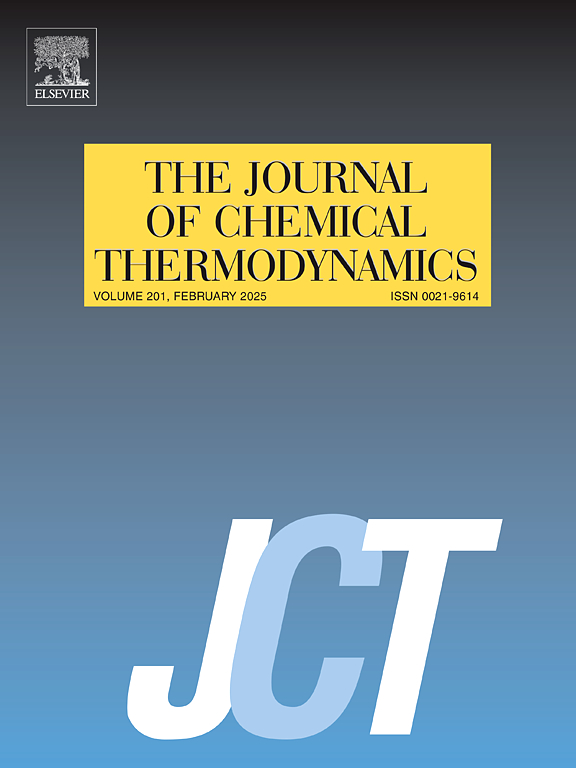Excess properties, intermolecular structure, and CO2 absorption performance of n-propanol/isopropanol and 3-diethylaminopropylamine binary mixed system
IF 2.2
3区 工程技术
Q3 CHEMISTRY, PHYSICAL
引用次数: 0
Abstract
In this work, the density (ρ) and viscosity (η) values were measured experimentally for the n-propanol (NPA) /isopropanol (IPA) (1) + 3-diethylaminopropylamine (DEAPA) Abd et al. (2020) (2) binary mixed system at T = 298.15–318.15 K and P = 100.5 kPa. To further study the physical and chemical properties of the binary mixed system, their excess molar volume (VmE), viscosity deviation (Δη), and excess Gibbs free energy (ΔG⁎E) were calculated, through which there is an interaction between 3-diethylaminopropylamine and n-propanol/isopropanol molecules. To validate the reliability of the basic data, several semi-empirical models were used to predict the experimental densities and viscosities, among which the Jouyban - Acree model (J-A) and the nonlinear least squares method for fitting the density data of the binary mixed system to the composition and temperature, the McAllister four-body viscosity model was used to fit the viscosity data to the composition of binary mixed systems, and the calculated results of ΔG⁎E, Δη and VmE were fitted using the Redlich-Kister (R - K) equations. In addition, the presence of intermolecular hydrogen bond (IHB) structure of the form as -OH···NH2- in the system was demonstrated by spectroscopic characterizations including Raman, ultraviolet (UV) and nuclear magnetic resonance hydrogen spectroscopy (1H NMR), and the existence of IHBs among the binary mixed system was further verified based on computational chemical theory. Finally, the CO2 uptake studies were conducted to compare with the monoamine and alcohol-amine mixed solutions to provide a new way for CO2 capture.
正丙醇/异丙醇与3-二乙基氨基丙胺二元混合体系的过量性能、分子间结构及CO2吸收性能
本文对正丙醇(NPA) /异丙醇(IPA)(1) + 3-二乙基氨基丙胺(DEAPA) Abd et al.(2020)(2)二元混合体系在T = 298.15-318.15 K和P = 100.5 kPa下的密度(ρ)和粘度(η)值进行了实验测量。为了进一步研究二元混合体系的物理和化学性质,计算了它们的过量摩尔体积(VmE)、粘度偏差(Δη)和过量吉布斯自由能(ΔG E),通过它们,3-二乙基氨基丙胺与正丙醇/异丙醇分子之间存在相互作用。为了验证基础数据的可靠性,采用了几种半经验模型对实验密度和粘度进行了预测,其中Jouyban - Acree模型(J-A)和非线性最小二乘法将二元混合体系的密度数据拟合到组成和温度,McAllister四体粘度模型将粘度数据拟合到二元混合体系的组成,并将计算结果ΔG E、Δη和VmE采用Redlich-Kister (R -K)方程拟合。此外,通过拉曼光谱、紫外光谱和核磁共振氢谱(1H NMR)表征证实了体系中存在- oh···NH2-形式的分子间氢键(IHB)结构,并基于计算化学理论进一步验证了二元混合体系中存在IHB。最后,与单胺和醇胺混合溶液进行CO2吸收研究,为CO2捕获提供新的途径。
本文章由计算机程序翻译,如有差异,请以英文原文为准。
求助全文
约1分钟内获得全文
求助全文
来源期刊

Journal of Chemical Thermodynamics
工程技术-热力学
CiteScore
5.60
自引率
15.40%
发文量
199
审稿时长
79 days
期刊介绍:
The Journal of Chemical Thermodynamics exists primarily for dissemination of significant new knowledge in experimental equilibrium thermodynamics and transport properties of chemical systems. The defining attributes of The Journal are the quality and relevance of the papers published.
The Journal publishes work relating to gases, liquids, solids, polymers, mixtures, solutions and interfaces. Studies on systems with variability, such as biological or bio-based materials, gas hydrates, among others, will also be considered provided these are well characterized and reproducible where possible. Experimental methods should be described in sufficient detail to allow critical assessment of the accuracy claimed.
Authors are encouraged to provide physical or chemical interpretations of the results. Articles can contain modelling sections providing representations of data or molecular insights into the properties or transformations studied. Theoretical papers on chemical thermodynamics using molecular theory or modelling are also considered.
The Journal welcomes review articles in the field of chemical thermodynamics but prospective authors should first consult one of the Editors concerning the suitability of the proposed review.
Contributions of a routine nature or reporting on uncharacterised materials are not accepted.
 求助内容:
求助内容: 应助结果提醒方式:
应助结果提醒方式:


